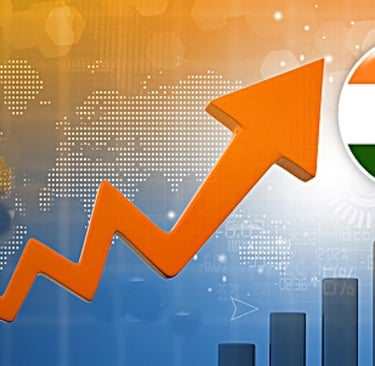It’s Not All Smooth Sailing — But Is India Really a Dead Economy?
Lately, you might’ve seen dramatic claims in political speeches or headlines calling India a “dead economy.” Let’s set the record straight: India is facing real economic challenges, but calling it dead is not just misleading—it’s wildly inaccurate. Here’s the truth.
RAVINDRA PRAJAPATI
8/2/20253 min read


India’s Economic Challenges Are Real, Not Terminal
Yes, India is navigating tough terrain:
Job creation is lagging, especially for youth and skilled workers.
The urban-rural divide continues to widen, creating unequal growth.
High public debt and inflation limit the government’s room to maneuver.
Climate shocks and trade risks threaten food and export security.
Many sectors are still bogged down by bureaucracy and red tape.
These aren’t small issues—they’re structural and demand urgent policy focus. But here’s the key: struggling doesn’t mean dying.
The Data Tells a Different Story
Despite the challenges, India’s economy is very much alive—and growing:
GDP growth is projected at 6.4%–6.6% in 2025, making India the fastest-growing G20 economy.
Stock markets have reached record highs.
Foreign investments in tech, infra, and startups are flowing steadily.
Major global firms like Apple, Google, Tesla, and Amazon are expanding their Indian footprint.
This kind of momentum is not what dead economies look like.
Dead Economy vs. Transforming Economy
Calling India a dead economy ignores the transitional phase it’s in—shifting:
From agrarian to industrial and service-based
From informal labor to formal job markets
From import dependence to production-linked growth
From low-tech to high-digital ecosystems
Transformations are messy. They're slower than headlines demand, but they’re happening.
Here are some holding back factor and sector for India-
Holding back factor - Agriculture: A Structural Bottleneck
Agriculture still employs 40–45% of the workforce, but contributes less than 18% to GDP.
Small landholdings, fragmented supply chains, and low mechanization trap farmers in a cycle of debt.
Climate change (erratic monsoons, heatwaves) adds uncertainty to yields.
MSP politics and outdated subsidy models strain public finance while failing to create lasting reform.
Unless agri-tech and supply chain modernization scale up fast, rural India will stay economically underpowered.
Holding back factor-Jobless Growth: The Paradox of GDP Without Jobs
India’s economy is growing, but employment isn’t. A big concern is the disproportionate rise in GDP versus job creation, especially in the formal sector.
Automation and tech adoption have reduced the need for mass labor in manufacturing and services.
Startups often scale without hiring large teams, thanks to AI and lean business models.
Over 30 million Indians are looking for jobs; a large chunk are educated but unemployed.
This trend risks fueling youth frustration, brain drain, and increased economic inequality.
Holding back factor- Regulatory Drag & Bureaucracy
India has improved in the Ease of Doing Business index, but:
Land acquisition is still a major bottleneck for industrial growth.
Tax complexity and compliance costs hit MSMEs hard.
Judicial delays in resolving contract or property disputes discourage investment.
Until governance reform becomes deeper and more localized, India will continue to face barriers to efficient business growth.
Holding back factor- Urban-Rural Divide & Inequality
India’s metros are booming, but much of rural India lags behind in:
Digital infrastructure
Health and education access
Reliable power and transport
This creates a dual-speed economy, where growth is concentrated in a few regions, leaving others behind. The result? Urban overcrowding, rural distress, and political discontent.
Holding back factor- Global Risks & Trade Exposure
India is vulnerable to external shocks, such as:
Geopolitical conflicts (China tension, Red Sea piracy, oil wars)
US/EU protectionism and tariff hikes
Supply chain disruptions due to global events (as seen during COVID-19 and the Russia-Ukraine war)
Overreliance on the Middle East for energy and China for components makes self-reliance (Atmanirbhar Bharat) a strategic necessity.
Holding back factor- The Skill Mismatch Crisis
India produces millions of graduates every year, but only a fraction are job-ready for high-demand sectors like AI, EVs, fintech, and advanced manufacturing.
Only 1 in 4 graduates are considered employable by industry standards (per India Skills Report).
Government schemes like Skill India are positive but underfunded and inconsistently executed.
Industries still rely on in-house training, slowing productivity in the short term.
Bridging the education-employment gap is critical for leveraging India's demographic dividend.
According to some facts - No, India Isn’t a Dead Economy
If anything, India is in a phase of intense restructuring and repositioning. The road isn’t smooth, but the engine is running—and gaining speed.
So, is it perfect? No.
Is it finished? Far from it.
Is it dead? Absolutely not.
RAVINDRA PRAJAPATI, Not a sebi registered
FOLLOW Us
ravindra.prajapati1122@gmail.com
+91 9795187745
© 2025. PiPiFinTech All rights reserved.
Contact Us
ABOUT Us
Our mission is to empower you to maximize every single penny and best solution for wealth generation and management for every mature age group.
Product TOPICS
Digital E-Wealth Platform
Mutual Funds
Education Planning
Insurance
FD and Bonds
Retirement Planning
Wealth Creation
(Disclaimers : Mutual Fund investments are subject to market risks, please read scheme related documents carefully.)
